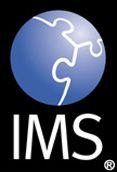 |
1EdTech Enterprise Services Common Data Definitions Version 1.0 Final Specification |
Copyright © 2004 1EdTech Consortium, Inc. All Rights Reserved.
The 1EdTech Logo is a registered trademark of 1EdTech Consortium, Inc.
Document Name: 1EdTech Enterprise Services Common Data Definitions
Revision: 11 June 2004
IPR and Distribution Notices
Recipients of this document are requested to submit, with their comments, notification of any relevant patent claims or other intellectual property rights of which they may be aware that might be infringed by any implementation of the specification set forth in this document, and to provide supporting documentation.
1EdTech takes no position regarding the validity or scope of any intellectual property or other rights that might be claimed to pertain to the implementation or use of the technology described in this document or the extent to which any license under such rights might or might not be available; neither does it represent that it has made any effort to identify any such rights. Information on 1EdTech's procedures with respect to rights in 1EdTech specifications can be found at the 1EdTech Intellectual Property Rights web page: http://www.imsglobal.org/ipr/imsipr_policyFinal.pdf.
Copyright © 2004 1EdTech Consortium. All Rights Reserved.
Permission is granted to all parties to use excerpts from this document as needed in producing requests for proposals.
Use of this specification to develop products or services is governed by the license with 1EdTech found on the 1EdTech website: http://www.imsglobal.org/license.html.
The limited permissions granted above are perpetual and will not be revoked by 1EdTech or its successors or assigns.
THIS SPECIFICATION IS BEING OFFERED WITHOUT ANY WARRANTY WHATSOEVER, AND IN PARTICULAR, ANY WARRANTY OF NONINFRINGEMENT IS EXPRESSLY DISCLAIMED. ANY USE OF THIS SPECIFICATION SHALL BE MADE ENTIRELY AT THE IMPLEMENTER'S OWN RISK, AND NEITHER THE CONSORTIUM, NOR ANY OF ITS MEMBERS OR SUBMITTERS, SHALL HAVE ANY LIABILITY WHATSOEVER TO ANY IMPLEMENTER OR THIRD PARTY FOR ANY DAMAGES OF ANY NATURE WHATSOEVER, DIRECTLY OR INDIRECTLY, ARISING FROM THE USE OF THIS SPECIFICATION.
Table of Contents
1. Introduction
1.1 Scope and Context
1.2 Structure of this Document
1.3 Nomenclature
1.4 References
2. Summary of Common Data Definitions
3. DataSource Class Data Model
3.1 Description
3.2 Attributes
3.3 Associations
3.4 OCL Definitions
3.5 XSD Binding
4. Email Class Data Model
4.1 Description
4.2 Attributes
4.3 Associations
4.4 OCL Definitions
4.5 XSD Binding
5. Identifier and IdentifierSet Class Data Model
5.1 Identifier Class Data Model
5.1.1 Description
5.1.2 Attributes
5.1.3 Associations
5.1.4 OCL Definitions
5.1.5 XSD Binding
5.2 IdentifierSet Class Data Model
5.2.1 Description
5.2.2 Attributes
5.2.3 Associations
5.2.4 OCL Definitions
5.2.5 XSD Binding
6. IdentifierPair and IdentifierPairSet Class Data Model
6.1 IdentifierPair Class Data Model
6.1.1 Description
6.1.2 Attributes
6.1.3 Associations
6.1.4 OCL Definitions
6.1.5 XSD Binding
6.2 IdentifierPairSet Class Data Model
6.2.1 Description
6.2.2 Attributes
6.2.3 Associations
6.2.4 OCL Definitions
6.2.5 XSD Binding
7. IMSextension Class Data Model
7.1 Description
7.2 Attributes
7.3 Associations
7.4 OCL Definitions
7.5 ExtensionField Class Data Model
7.5.1 Description
7.5.2 Attributes
7.5.3 Associations
7.5.4 OCL Definitions
7.6 XSD Binding
8. LangString and SeqLangString Class Data Models
8.1 LangString Class Data Model
8.1.1 Description
8.1.2 Attributes
8.1.3 Associations
8.1.4 OCL Definitions
8.1.5 XSD Binding
8.2 SeqLangString Class Data Model
8.2.1 Description
8.2.2 Attributes
8.2.3 Associations
8.2.4 OCL Definitions
8.2.5 XSD Binding
9. RecordMetadata Class Data Model
9.1 Description
9.2 Attributes
9.3 Associations
9.4 OCL Definitions
9.5 XSD Binding
10. Status and StatusInfoSet Class Data Model
10.1 Status Class Data Model
10.1.1 Description
10.1.2 Attributes
10.1.3 Associations
10.1.4 OCL Definitions
10.1.5 CodeMajor/Severity Interpretation Matrix
10.1.6 CodeMinor Values
10.1.7 XSD Binding
10.2 StatusInfoSet Class Data Model
10.2.1 Description
10.2.2 Attributes
10.2.3 Associations
10.2.4 OCL Definitions
10.2.5 XSD Binding
11. TimeFrame Class Data Model
11.1 Description
11.2 Attributes
11.3 Associations
11.4 OCL Definitions
11.5 RestrictDate Class Data Model
11.5.1 Description
11.5.2 Attributes
11.5.3 Associations
11.5.4 OCL Definitions
11.6 XSD Binding
12. URL Class Data Model
12.1 Description
12.2 Attributes
12.3 Associations
12.4 OCL Definitions
12.5 XSD Binding
13. UserId Class Data Model
13.1 Description
13.2 Attributes
13.3 Associations
13.4 OCL Definitions
13.5 XSD Binding
14. Message Header Structures
14.1 Synchronous Request Message Header
14.1.1 <messageIdentifier> Element
14.2 Synchronous Response Message Header
14.2.1 <messageIdentifier> Element
14.2.2 <statusInfo> Element
14.2.3 <statusInfoSet> Element
14.3 Asynchronous Request Message Header
14.3.1 <messageIdentifier> Element
14.4 Asynchronous Request Acknowledgement Message Header
14.4.1 <messageIdentifier> Element
14.4.2 <statusInfo> Element
14.5 Asynchronous Response Message Header
14.5.1 <messageIdentifier> Element
14.5.2 <statusInfo> Element
14.5.3 <statusInfoSet> Element
14.6 Asynchronous Response Acknowledgement Message Header
14.6.1 <messageIdentifier> Element
14.6.2 <statusInfo> Element
Appendix A - XSD Binding Files for Common Objects
About This Document
List of Contributors
Revision History
Index
1. Introduction
1.1 Scope and Context
This document contains the definition of data models that are available to all of the 1EdTech specification information models. A specific information model is responsible for establishing and explaining the context within which the classes defined herein are used. These models are described using the Unified Modelling Language (UML) and the syntax adopted for the description of the UML is given in the 1EdTech Specifications, Methods and Best Practices document [SpecDev, 03]. The corresponding XML bindings, using XML Schema Definitions (XSDs) are also supplied for each class. This component-based approach to specification development is explained in the 1EdTech Abstract Framework [AbsWhite, 03], [AbsGloss, 03], [AbsASCs, 03].
The content of this document will grow as the set of 1EdTech specifications expands. Each specification development activity will identify new common data models that should be made available outside of the specification being defined. This means that this document will undergo regular extension however new data models will not, in all but the rarest cases, require changes to any of the other established data models.
1.2 Structure of this Document
The structure of this document is:
1.3 Nomenclature
| IAF | 1EdTech Abstract Framework |
| UML | Unified Modelling Language |
| URL | Universal Resource Locator |
| W3C | World Wide Web Consortium |
| WSDL | Web Services Description Language |
| XML | Extensible Mark-up Language |
1.4 References
2. Summary of Common Data Definitions
The set of common data definitions described in this document is summarized in Table 2.1.
3. DataSource Class Data Model
3.1 Description
The DataSource class diagram is shown in Figure 3.1. The DataSource class is the container for any form of global unique or locally unique identifier that refers to the original source of the identifier. There is no internal sub-structure defined for the DataSource.
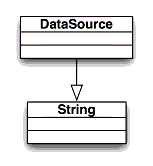
3.2 Attributes
3.3 Associations
The set of associations for the Identifier class are summarized in Table 3.1.
| Association Class Name | Multiplicity | Description |
|---|---|---|
| String | 1 | A DataSource is a type of String. |
3.4 OCL Definitions
The associated object constraint language description for this class is:
package Common
context Identifier
inv: DataSource.size <= 2048
3.5 XSD Binding
The XML binding for the DataSource class is shown in Figure 3.2. This binding is based upon the simple-type 'string'. The XSD listing is given in Appendix A.
4. Email Class Data Model
4.1 Description
The Email class diagram is shown in Figure 4.1. The Email class is the container for any email address. There is no internal sub-structure defined for the Email.
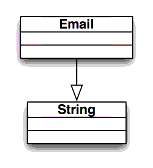
4.2 Attributes
4.3 Associations
The set of associations for the Identifier class are summarized in Table 4.1.
| Association Class Name | Multiplicity | Description |
|---|---|---|
| String | 1 | An Email is a type of String. |
4.4 OCL Definitions
The associated object constraint language description for this class is:
package Common
context Identifier
inv: Email.size <= 2048
4.5 XSD Binding
The XML binding for the Email class is shown in Figure 4.2. This binding is based upon the simple-type 'string'. The XSD listing is given in Appendix A.
5. Identifier and IdentifierSet Class Data Model
5.1 Identifier Class Data Model
5.1.1 Description
The Identifier class diagram is shown in Figure 5.1. The Identifier class is the container for any form of global unique or locally unique identifier. There is no internal sub-structure defined for the Identifier.
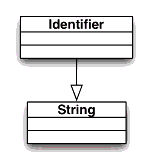
5.1.2 Attributes
5.1.3 Associations
The set of associations for the Identifier class are summarized in Table 5.1.
| Association Class Name | Multiplicity | Description |
|---|---|---|
| String | 1 | An Identifier is a type of String. |
5.1.4 OCL Definitions
The associated object constraint language description for this class is:
context Identifier inv: identifier.size <= 4096
5.1.5 XSD Binding
The XML binding for the Identifier class is shown in Figure 5.2. This binding is a simple-type 'string'. The XSD listing is given in Appendix A.
5.2 IdentifierSet Class Data Model
5.2.1 Description
The IdentifierSet class diagram is shown in Figure 5.3. The IdentifierSet class is a collection of Identifiers.
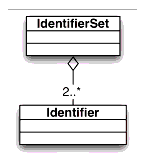
5.2.2 Attributes
5.2.3 Associations
The set of associations for the IdentifierSet class are summarized in Table 5.2.
| Association Class Name | Multiplicity | Description |
|---|---|---|
| Identifier | 2..* | The set of Identifiers. The significance of the order of the Identifiers is not defined as part of the class. |
5.2.4 OCL Definitions
5.2.5 XSD Binding
The XML binding for the IdentifierSet class is shown in Figure 5.4. This binding is based upon the creation of the complex-type 'identifierSetDType'. The XSD listing is given in Appendix A.
6. IdentifierPair and IdentifierPairSet Class Data Model
6.1 IdentifierPair Class Data Model
6.1.1 Description
The IdentifierPair class diagram is shown in Figure 6.1. The IdentifierPair is a tuple of Identifiers whose relationship is not defined as part of the class. The relationship is defined by the context of use.
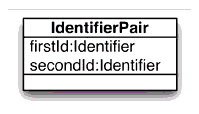
6.1.2 Attributes
The set of attributes for the IdentifierPair class are summarized in Table 6.1.
| Attribute Name | Type | Multiplicity | Description |
|---|---|---|---|
| firstId | Identifier | 1 | The first Identifier. |
| secondId | Identifier | 1 | The second Identifier. |
6.1.3 Associations
6.1.4 OCL Definitions
6.1.5 XSD Binding
The XML binding for the Identifier class is shown in Figure 6.2. This binding is based upon the creation of the complex-type 'identifierPairDType'. The XSD listing is given in Appendix A.

6.2 IdentifierPairSet Class Data Model
6.2.1 Description
The IdentifierPairSet class diagram is shown in Figure 6.3. The IdentifierPairSet is a collection of IdentifierPairs.
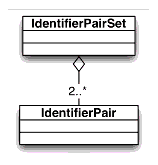
6.2.2 Attributes
6.2.3 Associations
The set of associations for the IdentifierPairSet class are summarized in Table 6.2.
| Association Class Name | Multiplicity | Description |
|---|---|---|
| IdentifierPair | 2..* | The set of IdentifierPairs. The significance of the order of the IdentifierPairs is not defined as part of the class. |
6.2.4 OCL Definitions
6.2.5 XSD Binding
The XML binding for the Identifier class is shown in Figure 6.4. This binding is based upon the creation of the complex-type 'identifierPairSetDType'. The XSD listing is given in Appendix A.
7. IMSextension Class Data Model
7.1 Description
The IMSextension class diagram is shown in Figure 7.1. The IMSextension class is used to enable proprietary extensions to be added to the data models defined within the 1EdTech service specifications.
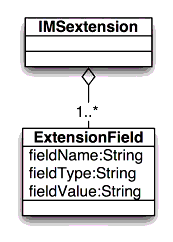
7.2 Attributes
7.3 Associations
The set of associations for the IMSextension class are summarized in Table 7.1.
| Association Class Name | Multiplicity | Description |
|---|---|---|
| ExtensionField | 1..* | The set of extension fields which are available to support the extensions to be defined. |
7.4 OCL Definitions
7.5 ExtensionField Class Data Model
7.5.1 Description
The ExtensionField class is a set name/type/value three-tuple that enables a single extension field to have a value assigned to the named field. This means that the set of extension fields must take the form of a flat list, i.e., no hierarchical extension forms are permitted.
7.5.2 Attributes
The set of attributes for the ExtensionField class are summarized in Table 7.2.
7.5.3 Associations
7.5.4 OCL Definitions
The associated object constraint language description for this class is:
context ExtensionField inv: fieldName.size <= 2048
inv: fieldType.size <= 2048
inv: fieldValue.size <= 2048
7.6 XSD Binding
The XML binding for the Identifier class is shown in Figure 7.2. This binding is based upon the creation of the complex-type 'IMSextensionDType'. The XSD listing is given in Appendix A.

8. LangString and SeqLangString Class Data Models
8.1 LangString Class Data Model
8.1.1 Description
The LangString class diagram is shown in Figure 8.1. This enforces the language of the text string to be supplied along with the text string itself.
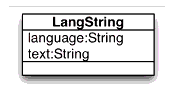
8.1.2 Attributes
The set of attributes for the LangString class are summarized in Table 8.1.
| Attribute Name | Type | Multiplicity | Description |
|---|---|---|---|
| language | String | 1 | The language of the text. This is an enumerated list from ISO 603. |
| text | String | 1 | The text entry itself. |
8.1.3 Associations
8.1.4 OCL Definitions
The associated object constraint language description for this class is:
package Common
context LangString
-- The LangString language set is as per ISO 603.
inv: Set{}.includes(language)
inv: text.size <= 2048
8.1.5 XSD Binding
The XML binding for the Identifier class is shown in Figure 8.2. This binding is based upon the creation of the complex-type 'LangStringDType'. The XSD listing is given in Appendix A.

8.2 SeqLangString Class Data Model
8.2.1 Description
The SeqLangString class diagram is shown in Figure 8.3. This enforces the language of the text string to be supplied along with the text string itself.

8.2.2 Attributes
8.2.3 Associations
The set of associations for the SeqLangString class are summarized in Table 8.2.
| Association Class Name | Multiplicity | Description |
|---|---|---|
| LangString | 2..* | The set of LangStrings. The significance of the order of the LangStrings is not defined as part of the class. |
8.2.4 OCL Definitions
None.
8.2.5 XSD Binding
The XML binding for the SeqLangString class is shown in Figure 8.4. This binding is based upon the creation of the complex-type 'SeqLangStringDType'. The XSD listing is given in Appendix A.

9. RecordMetadata Class Data Model
9.1 Description
The RecordMataData class diagram is shown in Figure 9.1. This class is the container for all object-specific descriptive meta-data that may be required to define the usage context of the object.

9.2 Attributes
The set of attributes for the RecordMetaData class are summarized in Table 9.1.
| Attribute Name | Type | Multiplicity | Description |
|---|---|---|---|
| comments | String | 0..1 | Human readable comments that are used to supply descriptive and contextual information about the object containing this class. |
Further attributes will be added as required by other objects. All of the attributes are optional.
9.3 Associations
9.4 OCL Definitions
The associated object constraint language description for this class is:
context RecordMetaData inv: comments.size <= 2048
9.5 XSD Binding
The XML binding for the Identifier class is shown in Figure 9.2. This binding is based upon the creation of the complex-type 'RecordMetaDataDType'. The XSD listing is given in Appendix A.
10. Status and StatusInfoSet Class Data Model
10.1 Status Class Data Model
10.1.1 Description
The StatusInfo class diagram is shown in Figure 10.1. This class is used to return the status information reporting on the outcome of the associated request.

10.1.2 Attributes
The set of attributes for the StatusInfo class are summarized in Table 10.1.
10.1.3 Associations
10.1.4 OCL Definitions
The associated object constraint language description for this class is:
context StatusInfo inv: Set{'Success', 'Processing', 'Failure', 'Unsupported'}.includes(codeMajor)
inv: Set{'Status', 'Warning', 'Error'}.includes(severity)
inv: codeMinorName.size <= 32
inv: codeMinorValue.size <= 32
inv: messageRefIdentifier.size <= 32
inv: operationRefIdentifier.size <= 32
10.1.5 CodeMajor/Severity Interpretation Matrix
The interpretation of the 'codeMajor/severity' matrix is shown in Table 10.2.
10.1.6 CodeMinor Values
The information to be entered in the 'codeMinorName' should reflect the service responsible for generating the state code. In the case of the Enterprise Services these will be:
- 'personmanagement' - for the Person Management Service;
- 'groupmanagement' - for the Group Management Service;
- 'membershipmanagement' - for the Membership Management Service;
The set of predefined 'codeMinor' codes available for entry in the 'codeMinorField' are listed in Table 10.3.
10.1.7 XSD Binding
The XML binding for the Identifier class is shown in Figure 10.2. This binding is based upon the creation of the complex-type 'statusInfoDType'. The XSD listing is given in Appendix B.
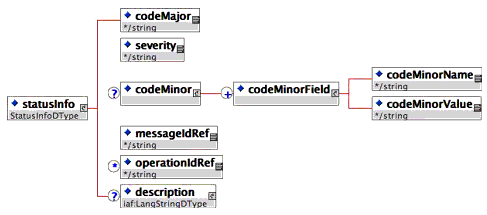
10.2 StatusInfoSet Class Data Model
10.2.1 Description
The StatusInfoSet class diagram is shown in Figure 10.3. This is a collection of StatusInfo classes and the order of these reflects the sequence in which the individual operations were requested.
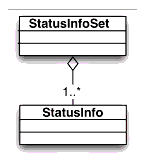
10.2.2 Attributes
10.2.3 Associations
The set of associations for the StatusInfoSet class are summarized in Table 10.4.
| Association Class Name | Multiplicity | Description |
|---|---|---|
| StatusInfo | 1..* | The status information class returned for each and every operation. Each StatusInfo instance references the status of each operation. |
10.2.4 OCL Definitions
10.2.5 XSD Binding
The XML binding for the Identifier class is shown in Figure 10.4. This binding is based upon the creation of the complex-type 'StatusInfoSetDType'. The XSD listing is given in Appendix B.
11. TimeFrame Class Data Model
11.1 Description
The TimeFrame class diagram is shown in Figure 11.1. The TimeFrame class defines the period for which a particular activity is permitted.

11.2 Attributes
The set of attributes for the TimeFrame class are summarized in Table 11.1.
11.3 Associations
11.4 OCL Definitions
The associated object constraint language description for this class is:
context TimeFrame -- Timeframe, where present, cannot be empty.
inv: adminPeriod.size <= 32
11.5 RestrictDate Class Data Model
11.5.1 Description
The RestrictDate class allows a restriction on an activity to be defined from a particular date.
11.5.2 Attributes
The set of attributes for the RestrictDate class are summarized in Table 11.2.
11.5.3 Associations
11.5.4 OCL Definitions
11.6 XSD Binding
The XML binding for the Identifier class is shown in Figure 11.2. This binding is based upon the creation of the complex-type 'TimeFrameDType'. The XSD listing is given in Appendix A.

12. URL Class Data Model
12.1 Description
The URL class diagram is shown in Figure 12.1. The URL class is the container for a Universal Resource Locator There is no internal sub-structure defined for the URL.
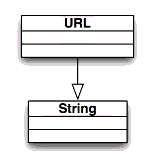
12.2 Attributes
12.3 Associations
The set of associations for the Identifier class are summarized in Table 12.1.
| Association Class Name | Multiplicity | Description |
|---|---|---|
| String | 1 | A URL is a type of String. |
12.4 OCL Definitions
The associated object constraint language description for this class is:
context Identifier inv: URL.size <= 4096
12.5 XSD Binding
The XML binding for the URL class is shown in Figure 12.2. This binding is based upon the simple-type 'string'. The XSD listing is given in Appendix A.
13. UserId Class Data Model
13.1 Description
The UserId class diagram is shown in Figure 13.1. This class is used to contain the information that defines the access control for a user to the learning environment.

13.2 Attributes
The set of attributes for the UserId class are summarized in Table 13.1.
13.3 Associations
13.4 OCL Definitions
The associated object constraint language description for this class is:
context UserId inv: userIdValue.size <= 256
inv: userIdType.size <= 32
inv: passWord.size <= 1024
inv: pwEncryption.size <= 32
inv: authentication.size <=32
13.5 XSD Binding
The XML binding for the Identifier class is shown in Figure 13.2. This binding is based upon the creation of the complex-type 'UserIdDType'. The XSD listing is given in Appendix A.
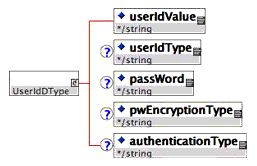
14. Message Header Structures
The following structures are the message headers that are to be used in the 'Request' and 'Response' messages exchanged to implement the behaviors.
14.1 Synchronous Request Message Header
The synchronous request message header structure is shown in Figure 14.1. The corresponding XSD definition is given in Appendix B.
14.1.1 <messageIdentifier> Element
This is the container for the unique message identifier. This is to be assigned by the system constructing the message header. It is the responsibility of the transmitting system to ensure that the message identifier is unique.
14.2 Synchronous Response Message Header
The synchronous response message header structure is shown in Figure 14.2. The corresponding XSD definition is given in Appendix B.

14.2.1 <messageIdentifier> Element
This is the container for the unique message identifier. This is to be assigned by the system constructing the message header. It is the responsibility of the transmitting system to ensure that the message identifier is unique.
14.2.2 <statusInfo> Element
The status information returned as a response to single transaction request; see sub-section 10.1.
14.2.3 <statusInfoSet> Element
The status information returned as a response to multiple transaction request; see sub-section 10.2.
14.3 Asynchronous Request Message Header
The synchronous request message header structure is shown in Figure 14.3. The corresponding XSD definition is given in Appendix B.
14.3.1 <messageIdentifier> Element
This is the container for the unique message identifier. This is to be assigned by the system constructing the message header. It is the responsibility of the transmitting system to ensure that the message identifier is unique.
14.4 Asynchronous Request Acknowledgement Message Header
The asynchronous request acknowledgement message header structure is shown in Figure 14.4. The corresponding XSD definition is given in Appendix B.

14.4.1 <messageIdentifier> Element
This is the container for the unique message identifier. This is to be assigned by the system constructing the message header. It is the responsibility of the transmitting system to ensure that the message identifier is unique.
14.4.2 <statusInfo> Element
The status information returned to indicate the initial status of the asynchronous request; see sub-section 10.1.
14.5 Asynchronous Response Message Header
The synchronous request message header structure is shown in Figure 14.5. The corresponding XSD definition is given in Appendix B.

14.5.1 <messageIdentifier> Element
This is the container for the unique message identifier. This is to be assigned by the system constructing the message header. It is the responsibility of the transmitting system to ensure that the message identifier is unique.
14.5.2 <statusInfo> Element
The status information returned as the final response to original transaction request; see sub-section 10.1.
14.5.3 <statusInfoSet> Element
The status information returned as the final response to the original multiple transaction request; see sub-section 10.2.
14.6 Asynchronous Response Acknowledgement Message Header
The asynchronous response acknowledgement message header structure is shown in Figure 14.6. The corresponding XSD definition is given in Appendix B.

14.6.1 <messageIdentifier> Element
This is the container for the unique message identifier. This is to be assigned by the system constructing the message header. It is the responsibility of the transmitting system to ensure that the message identifier is unique.
14.6.2 <statusInfo> Element
The status information returned to indicate the final status of the asynchronous request; see sub-section 10.1.
Appendix A - XSD Binding Files for Common Objects
The set of XML binding files for the common objects are listed in Table A.1. The file names are hot links to the files themselves.
| Description | File Name |
|---|---|
| XML binding of the common data objects | /services/common/imsCommonSchema_v1p0.xsd |
| XML binding of the message headers | /services/common/imsMessBindSchema_v1p0.xsd |
About This Document
| Title | 1EdTech Enterprise Services Common Data Definitions Specification |
| Editor | Colin Smythe (1EdTech) |
| Team Co-Lead | Chris Vento (WebCT Inc.) |
| Version | 1.0 |
| Version Date | 11 June 2004 |
| Status | Final Specification |
| Summary | This document presents the 1EdTech Enterprise Services Common Data Definitions Information Model and XML Binding. The classes described within this document are available as foundation classes to all of the service specifications. This document also includes the XML Binding of the operation message headers for the synchronous and asynchronous protocols. |
| Revision Information | 11 June 2004 |
| Purpose | This document has been approved by the 1EdTech Technical Board and is made available for adoption. |
| Document Location | http://www.imsglobal.org/es/esv1p0/imscommon_infov1p0.html |
| To register any comments or questions about this specification please visit: http://www.imsglobal.org/developers/ims/imsforum/categories.cfm?catid=20 |
List of Contributors
The following individuals contributed to the development of this document:
Revision History
Index
A
Abstract Framework 1, 2
Asynchronous Request Message 1
Asynchronous Response Message 1
Attributes
Common
extension 1, 2, 3, 4 ExtensionField
fieldName 1
fieldValue 1 Identifier
firstId 1
secondId 1 LangString
language 1, 2, 3, 4, 5, 6, 7, 8, 9, 10, 11, 12
comments 1 Result
result 1 Role
status 1, 2, 3, 4, 5, 6 StatusInfo
description 1, 2, 3, 4, 5, 6, 7, 8, 9, 10, 11, 12
adminPeriod 1
begin 1
end 1 TypeValue
passWord 1
userIdType 1
userIdValue 1 Values
Identifier 1, 2, 3, 4, 5, 6, 7, 8, 9, 10, 11, 12, 13, 14, 15
Description 1, 2, 3, 4, 5, 6, 7, 8, 9, 10, 11, 12, 13, 14, 15, 16, 17, 18, 19, 20, 21 Membership 1
Person 1
Name 1, 2, 3, 4, 5, 6, 7, 8, 9, 10, 11, 12, 13, 14 Role
Values 1
G
Group Management Service 1
M
Membership Management Service 1
Message headers
Asynchronous Request 1
Asynchronous Response 1
Synchronous Request 1
Synchronous Response 1
O
OCL 1, 2, 3, 4, 5, 6, 7, 8, 9, 10, 11, 12, 13, 14, 15, 16, 17
P
Person Management Service 1
S
Services
Group Management 1
Membership Management 1
Person Management 1
Status Codes
fullsuccess 1
idallocfail 1
overflowfail 1
unsupported 1
Synchronous Request Message 1
Synchronous Response Message 1
W
WDSL 1
1EdTech Consortium, Inc. ("1EdTech") is publishing the information contained in this 1EdTech Enterprise Services Common Data Definitions ("Specification") for purposes of scientific, experimental, and scholarly collaboration only.
1EdTech makes no warranty or representation regarding the accuracy or completeness of the Specification.
This material is provided on an "As Is" and "As Available" basis.
The Specification is at all times subject to change and revision without notice.
It is your sole responsibility to evaluate the usefulness, accuracy, and completeness of the Specification as it relates to you.
1EdTech would appreciate receiving your comments and suggestions.
Please contact 1EdTech through our website at http://www.imsglobal.org
Please refer to Document Name: 1EdTech Enterprise Services Common Data Definitions Revision: 11 June 2004


